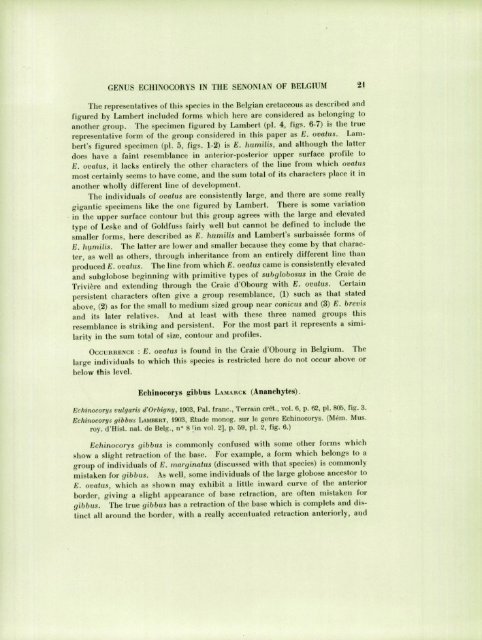ECIIINOID GENUS ECHINOCOIÎYS
ECIIINOID GENUS ECHINOCOIÎYS
ECIIINOID GENUS ECHINOCOIÎYS
Create successful ePaper yourself
Turn your PDF publications into a flip-book with our unique Google optimized e-Paper software.
<strong>GENUS</strong> ECHINOCORYS IN THE SENONIAN OF BELGIUM 21<br />
The representatives of this species in the Belgian cretaceous as described and<br />
figured by Lambert included forms which here are considered as belonging to<br />
another group. The specimen figured by Lambert (pi. 4, figs. 6-7) is the true<br />
representative form of the group considered in this paper as E. ovatus. Lambert's<br />
figured specimen (pi. 5, figs. 1-2) is E. humilis, and although the latter<br />
does have a faint resemblance in anterior-posterior upper surface profile to<br />
E. ovatus, it lacks entirely the other characters of the line from which ovatus<br />
most certainly seems to have come, and the sum total of its characters place it in<br />
another wholly different line of development,<br />
The individuals of ovatus are consistently large, and there are some really<br />
gigantic specimens like the one figured by Lambert. There is some variation<br />
in the upper surface contour but this group agrees with the large and elevated<br />
type of Leske and of Goldfuss fairly well but cannot be defined to include the<br />
smaller forms, here described as E. humilis and Lambert's surbaissée forms of<br />
/;. humilis. The latter are lower and smaller because they come by that character,<br />
as well as others, through inheritance from an entirely different line than<br />
produced E. ovatus. The line from which E. ovatus came is consistently elevated<br />
and subglobose beginning with primitive types of subglobosus in the Craie de<br />
Trivière°and extending through the Craie d'Obourg with E. ovatus. Certain<br />
persistent characters often give a group resemblance, (1) such as that stated<br />
above (2) as for the small to medium sized group near conicus and (3) E. brevis<br />
and its later relatives. And at least with these three named groups this<br />
resemblance is striking and persistent, For the most part it represents a similarity<br />
in the sum total of size, contour and profiles.<br />
OCCURRENCE : E. ovatus is found in the Craie d'Obourg in Belgium. The<br />
lar«-e individuals to which this species is restricted here do not occur above or<br />
below this level.<br />
Echinocorys gibbus<br />
LAMARCK (Ananchytes).<br />
Echinocorys vulgaris d'Orbigny, 1903, Pal. franc, Terrain crét., vol. 6, p. 62, pi. 805, fig. 3.<br />
Echinocorys gibbus LAMBERT, 1903, Étude monog. sur le genre Echinocorys. (Mém. Mus.<br />
roy. d'Hist. nat. de Belg., n° 8 [in vol. 2], p. 59, pi. 2, fig. 6.)<br />
Echinocorys gibbus is commonly confused with some other forms which<br />
show a slight retraction of the base. For example, a form which belongs to a<br />
group of individuals of E. marginatus (discussed with that species) is commonly<br />
mistaken for gibbus. As well, some individuals of the large globose ancestor to<br />
E. ovatus, which as shown may exhibit a little inward curve of the anterior<br />
border giving a slight appearance of base retraction, are often mistaken for<br />
gibbus'. The true gibbus has a retraction of the base which is complets and distinct<br />
all around the border, with a really accentuated retraction anteriorly, and

















